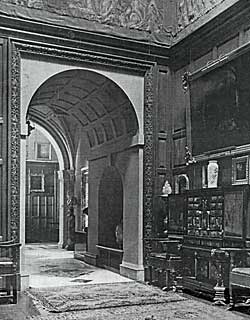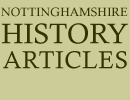
IN the year 1654 John Evelyn of Wotton and his wife, travelling about England in handsome, and leisurely fashion, came to Welbeck, "the house of the Marques of Newcastle, seated in a botome in a park and environ'd with woods, a noble yet melancholy seate." In some such words we might still describe Welbeck Abbey, still the seat of the descendants of the Evelyns' Marquess. Like Woburn, another abbatial house of another English duke, Welbeck lies low, a building site chosen by religious men who asked retirement and shelter; but if the low site by the water-side be melancholy, let us remember that the park which rings it round, a vast deer park with eight miles of boundary, is the merry greenwood of Robin Hood's forest of Sherwood. Before the venerable Green Dale oak, which, propped on crutches, still puts forth from its hollow body a living bough, we cannot surrender Robin Hood to those grudging historians who would describe him as a folk-myth. Here are trees which in their youth saw him range the greenshaws with Marian and Little John, Scathelock and Much the Miller's son. Not far away is Newstead, where we may see his cave, and hard by is Fountain Dale, where he first countered with the curtal friar. That the Sherwood land is poor land for the ploughman is something for rejoicing; its wild poverty has saved to England a broad piece of one of those forests which once ran from sea to sea.
The house's name tells its history. This Welbeck was once an abbey of Premonstratensians, an offshoot from New-house, founded here in the twelfth century by Thomas, son of Richard of Cuckney, lord of the lands in Cuckney which his ancestor, Joce the Fleming, had in the Conqueror's time. This Thomas gave of his Cuckney lands to Berengar, abbot of Welbeck, and to the canons of the house, by a charter executed soon after Henry II., aided by Thomas and others like unto him, had come to the throne. The register of theabbey proudly records that Thomas the founder was vir bellicosus — a man of war — during all the struggle with King Stephen, having built at Cuckney one of those castles which so moved to hatred the chroniclers of King Stephen's reign. A second founder and patron of this house was John Hotham, bishop of Ely, who acquired the whole manor of Cuckney in the fourteenth century and settled the same upon the abbey, adding eight canons to its stalls. After this Welbeck prospered, and was the chief house of the Premonstratensian order in England when Henry VIII. dissolved the abbeys. Welbeck shared the common lot, and its site was bought by one Richard Whalley. From the Whalleys it passed by purchase to Sir Charles Cavendish, who at the beginning of the reign of James I. began to pull down the old walls and change a house of religious into, a seat for the dukes who were to come of his loins.
Sir Charles Cavendish was a younger son of Bess of Hardwick, the Derbyshire heiress, whose ancestral home of Hardwick is less than ten miles from Welbeck, over the county border. By her second marriage, this famous lady, who was four times a wife and long outlived her fourth husband, had two sons who founded ducal houses, the Duke of Devonshire descending from an elder brother of Sir Charles. His mother's passion for building must have taken Sir Charles Cavendish, for in his time the ancient abbey and abbey church of Welbeck disappeared into his new work.
Legend has it that even now the tombs of the abbey church remain, that the effigies of the Cuckneys and their heirs and the sleeping abbots clad in stone still lie boxed in some forgotten place, behind walls or masking panels within this mass of buildings.

Dining-room Lobby.
By his wife Catherine, the heir of the Northumberland Ogles, Sir Charles begat William Cavendish, a successful courtier at a time when the Court offered a great career for a well-born young man of good presence. While still a lad, he was created Knight of the Bath, and in 1619 King James honoured Welbeck with one of his costly visits, the host being Viscount Mansfield before the next year's end. Eight years afterward he was Earl of Newcastle, and the Ogle estates falling to his hand, he was able in 1633 to spend between £4.000 and £5,000 in entertaining the new King at Welbeck. For this occasion Ben Jonson composed his masque, entitled "The King's Entertainment at Welbeck." In the following year the King (accompanied by Queen Henrietta Maria) was again entertained at Welbeck, Jonson writing another masque, called "Love's Welcome," which was performed at the Earl's other seat, Bolsover Castle. The cost of this visit was nearly £15,000. Newcastle was named governor to the young Prince of Wales, and places and pensions were coming to his hands when the wars began, and all his gains were in peril. He commanded in the North, and at his own charges raised troops which he led into Yorkshire. By the fight at Adwalton he won Yorkshire for the King, and in 1643 he had the barren honour of changing his earldom for a marquessate. After Marston Moor, where he fought as a simple volunteer, having vainly urged Rupert to wait for reinforcements, he washed his hands of civil war and went oversea to Hamburg, where began sixteen years of wandering exile. In exile he met and married his second wife, Margaret Lucas, sister of the Sir Charles Lucas who died for his defence of Colchester, her jewels being pawned for their household need. In exile, too, he wrote his famous book on the menage, he being the great horse-master of his day. At the Restoration they came home again to find themselves an old and fantastic couple in a Court which mocked behind their backs. He had spent, by his own showing, a million in the royal cause, and his estates were never wholly restored. As Duke and Duchess of Newcastle, the husband and wife withdrew to their old home at Welbeck, where they might solace themselves with the interminable plays, verses, and essays which set them among Walpole's "noble authors." The second Duke, who died at Welbeck in 1691, saw his son, the Lord Ogle, die in his own lifetime, and was succeeded by his five daughters and co-heirs, of whom Margaret, the third daughter, godchild of Duchess Margaret, was wife to John Holles, Earl of Clare, in whom the ducal title of Newcastle was revived. Their only daughter became the wife of Edward Harley, second Earl of Oxford, and friend of Pope and Swift. The Earl's only surviving child was Lady Margaret Cavendish Harley, through whose marriage with the second Duke of Portland the Welbeck estates have descended to the Bentincks.
